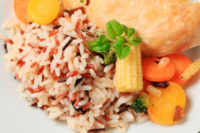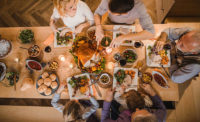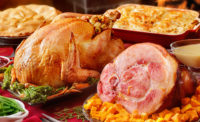Formulation Strategies | Holiday Dinners
Holiday meats: nostalgia vs. novelty
'Tis the season to plan for holiday business with traditional meats, but shoppers also want cultural diversity, unique meal options and meal delivery systems.

Not all traditions are made to be broken. What’s Thanksgiving without turkey, after all? Or Christmas without ham or beef, or Hanukkah without beef brisket? Meat and poultry certainly are the stars of holiday meals, but younger consumers are putting their own spin on recipes, menu kits and meal delivery for new traditions.
“Holidays are closely interwoven with culture and tradition,” says Anne-Marie Roerink, principal and founder of 210 Analytics, based in San Antonio, Texas. “So as much as how we eat, how we shop and how we cook has changed in our everyday lives, we see lots of traditional protein choices during the big holidays, including Thanksgiving, Christmas, New Year’s and Easter.”
The vast majority of shoppers will buy whole turkeys and large hams during the holidays, which is unlikely to change any time soon. “However, we do see smaller spikes in specialty items, such as very high-end cuts of beef, duck, quail, etc., driven by shoppers looking to shake things up a little,” says Roerink. “Recipe Web sites certainly offer alternate ideas, and for retailers it could be an interesting way to drive high-ring, high-margin items, while needing to compete on price per pound on their turkey offering.”
As one might imagine, turkey is most common and predominantly consumed around Thanksgiving. “There are other traditions such as ham and goose, but those are far less common than turkey,” says Maeve Webster, president of Menu Matters, based in Arlington, Vt.
Dining out for the holidays
Apparently home-cooked meals are most popular during the holidays, even for time-pressed younger consumers.
"Many restaurants, particularly dine-in restaurants, notice a decline in patrons during a seasonal holiday,” says Anne-Marie Roerink, principal and founder of 210 Analytics, based in San Antonio. “Many customers are less likely to eat out as they are spending time with family and preparing their traditional meals at home."
In response, some restaurants now offer delivery or pick up for holiday meals, directly competing with retailers, she says.
"A major advantage for restaurants is that they can bolt on holiday specials to their regular menu offerings, thus offering the variety that some shoppers are looking for," says Roerink.
The basics are still popular. "If you look at LTOs (limited-time offers) that come out during this time from restaurants, the flavors and ingredients are typically what you’d expect — again from an American/Western European point of view — peppermint, cinnamon, turkey, ham, cranberries, nutmeg, typically richer, more indulgent which reflects both the holiday season as well as the time of year — colder, prone to comfort and treating one’s self," says Maeve Webster, president of Menu Matters, in Arlington, Vt.
Sandwiches are the largest item type for holiday-inspired turkey rollouts, followed by center-of-plate turkey and turkey burgers, says Joe Garber, marketing coordinator at Datassential, in Chicago. "In fact, turkey sandwich introductions peak around October and November," he says. "As of 2016, they accounted for about a quarter of all sandwich intros in both of those months. Sandwiches also offer operators a vehicle for introducing innovative ways to menu a holiday-themed sandwich."
So, even with restaurant dining, there’s no escaping turkey sandwiches after Thanksgiving.
And consumers would like even more turkey during Thanksgiving. “Forty-four percent of consumers would like more restaurants to offer holiday specials featuring turkey, according to Technomic’s 2017 Center of the Plate: Poultry Consumer Trend Report,” says Lizzy Freier, managing editor, menu analysis at Technomic, based in Chicago.
While there may not be data on how consumers feel about holiday meals, based on several menu items it’s clear tradition counts. “Turkey, ham, stuffing, gravy and cranberry sauce — these are main foods that evoke a sense of nostalgia around the season, so it’s important for producers and operators to leverage this while marketing meat and poultry products,” says Joe Garber, marketing coordinator at Datassential, in Chicago. “Consider providing a recipe that takes these holiday staples and adds a fresh trend, such as a cranberry chutney or new style of bread.”
For Christmas, many traditions vary widely by region and family. “Turkey, ham and roast beef are probably most commonly sought out for the Christmas holiday, but clams, crown roast, lamb and other proteins also have a place depending on the region and the tradition,” Webster says.
These meals, however, are all based on traditional American celebrations. “As other demographics become more influential, their preferences for either Thanksgiving or Christian holidays will likely vary widely and present completely new opportunities for retailers and restaurants,” Webster says. “And, of course, other holidays are likely to become more impactful at various times of year, not just at year-end, and offer new opportunities for retailers and restaurants as well.”
According to Datassential’s 2017 Meat + Poultry Keynote, new chicken introductions dip in December and peak in January — perhaps attempting to appeal to healthier resolutions following holiday indulgence, says Garber.
Creating new holiday traditions
The shift in culinary innovation and meat shopping behavior over the past two to three years, however, has been game-changing. “From local trends, new meat cuts, infused ethnic tastes and meal kits, both retail and foodservice have experimented and/or adopted innovative ways to deliver food to consumers and the holidays will be no different,” says Steve Hixon, account management director, Midan Marketing, based in Chicago.
Thanksgiving is typically a family gathering consisting of the traditional turkey and/or ham as the staple center-of-plate proteins, but the holiday season in general consists of family events and occasions celebrated with protein, he says.
“This will likely stay consistent this year; however, the preparation of the protein and the accompaniments may include unique flavors, new recipes and the purchase of side dishes from restaurants delivered via home delivery services such as Uber Eats or Amazon Fresh,” says Hixon. “The remainder of the holiday season will most likely consist of more retail purchases of turkey and ham, along with ribeye for prime rib, beef chuck and rounds for roasts, pork tenderloin and pork butts and beef variety meats through the December holidays.”
Retailers should capitalize on these opportunities by merchandising these proteins with recipe ideas, as meal kits and ethnic flavor offerings, Hixon says.
“Restaurants, as usual, should benefit from New Year’s Eve and New Year’s Day,” he says. “Beef tenderloin and prime rib are traditional favorites, along with pork cuts such as chops, tenderloins and butts.”
More retailers and others offer convenience-focused solutions ranging from ready-to-heat meal solutions to holiday meal kits to convenient stations with all items for the holiday meal. “Many retailers with foodservice offerings now offer extensive holiday meal plans with a pick-and-choose your sides, main meat, etc., solution ready for pick up,” Roerink says.
Shoppers look to repeat family traditions, and the Thanksgiving turkey is very much part of that. “But there are new sub-trends within the ‘holiday bigs’ and they are closely related to trends we see in the everyday meat purchase,” says Roerink. “These are mega trends such as convenience, animal welfare/other transparency claims and technology.”
For instance, dollar sales growth is seen for organic as well as antibiotic-free turkey, she says. “This is right in line with continued double-digit growth in all meat and poultry that is marketed as antibiotic free or never antibiotics ever,” says Roerink.
Another area to keep in mind is the current trade dispute and the imposed tariffs negatively affecting U.S. pork exports to Mexico and China, Hixon says.
“This situation is creating opportunities for U.S. consumers to purchase domestic pork at lower-than-usual prices,” Hixon says. “More retailers are featuring pork (as well as beef and poultry) due to lower export volumes, resulting in increased domestic supplies. More retailers will likely feature pork and beef loin and rib cuts during the pre-holiday season and take advantage of plentiful inventory and lower-than-normal prices.”
Capitalizing on new shopping behaviors
Today’s consumer is shifting. Millennials will soon surpass Boomers in population size by 2019, and Gen Xers are constantly strapped for time managing a family of three to four. What do they want? These shoppers have long shown an interest in cultural diversity and unique meal options and meal delivery systems, says Hixon, referring to Tomorrow’s Consumer, Are you Ready? by Midan Marketing in 2018.
“Searching for local ingredients and meat protein selections are not new but continue to be sought after, new meat cuts are being used in restaurants in a tapas format and meal delivery options are vast and they are continuing to add restaurants to their cuisine selection list,” Hixon says.
But when it comes to holidays, even younger consumers will seek some traditional experiences along with introducing foods that may spark a new family tradition.
Innovative merchandising ideas for protein will only attract today’s consumer. “Offer ethnic flavors, provide multi-program selections from grade quality, claims on package to unique cuts of meat creatively presented on menu or in the retail service case,” says Hixon.
So while tradition does drive most holiday celebrations, it also depends on just what the tradition is and where the tradition is coming from (here or abroad).
“That said, I think consumers are usually willing, within their means, of paying more for better quality than what they may typically purchase for day-to-day consumption,” Webster says. “Quality definitely becomes a bigger driver for celebrations. ‘Something new’ is likely impacting more of the sides and desserts, outside of more traditional celebrations.” NP
Looking for a reprint of this article?
From high-res PDFs to custom plaques, order your copy today!








